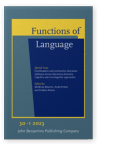The linguistic realization of continuative discourse relations in English discourse
A context-based analysis across narrative and argumentative genres
This paper examines the linguistic realization of continuative discourse relations in British English written
discourse comparing narrative and argumentative dyadically edited texts. The data comprise 18 co-edited texts and metadata
documenting the editing process (keystroke logs and transcripts of the dyads negotiating discursive well-formedness). The focus of
analysis lies on the linguistic realization of coordinating continuation and narration, which keep the discourse
on the same level, and on the linguistic realization of subordinating elaboration and explanation, which
introduce a deeper level in the discourse hierarchy. Special attention is paid to contexts in which the discourse relations are
encoded in intra-clausal coherence strands, and to contexts in which they are additionally signalled in the peripheries. The
quantitative analysis of the signalling of continuative discourse relations shows genre-specific preferences for the signalling of
continuation and elaboration in the argumentative data, and continuation, narration and
explanation in the narrative data. Both the products of the edited data, the co-edited texts, and the metadata show
that the linguistic realization and interpretation of continuative discourse relations are – to varying degrees – subject to
recontextualization. We suggest that this variation provides evidence for (1) discourse relations as constitutive parts of
discourse grammar, and (2) genre as a blueprint which constrains their linguistic realization.
Article outline
- 1.Introduction
- 2.Continuative discourse relations
- 3.Method and data
- 4.Results
- 4.1Quantitative analysis
- 4.2Qualitative analysis
- 4.2.1Argumentative data
- 4.2.2Narrative data
- 5.Discussion
- 6.Conclusion
- Acknowledgements
- Notes
-
References
References (38)
References
Asher, Nicholas & Alex Lascarides. 2003. Logics
of
conversation. Cambridge: CUP.
Asr, Fatemeh Torabi & Vera Demberg. 2012. Implicitness of discourse relations. In Martin Kay & Christian Boitet (eds.), Proceedings of COLING 2012: Technical papers, 2669–2684. Mumbai, India: The COLING 2012 Organizing Committee.
Bellos, David. 2013. The
solitary monoglots. The Guardian, 19 August 2013, p. 23.
Benamara Zitoune, Farah & Maite Taboada. 2015. Mapping different rhetorical relation annotations: A proposal. In Martha Palmer, Gemma Boleda & Paolo Rosso (eds.), Proceedings of the Fourth Joint Conference on Lexical and Computational Semantics (SEM 2015), 147–152. Denver, CO: Association for Computational Linguistics. 

Bublitz, Wolfram & Uta Lenk. 1999. Disturbed
coherence: ‘Fill me in’. In Wolfram Bublitz, Uta Lenk & Eija Ventola (eds.), Coherence
in spoken and written discourse: How to create it and how to describe it. Selected papers from the International Workshop on
Coherence, Augsburg, 24–27 April
1997, 153–174. Amsterdam: Benjamins. 

Clark, Billy. 2013. Relevance
Theory. Cambridge: CUP. 

Crible, Ludivine & Vera Demberg. 2020. When
do we leave discourse relations underspecified? The effect of formality and relation
type. Discours 261. 

Dale, Robert. 1991. Exploring
the role of punctuation in the signalling of discourse structure. Proceedings of the Workshop
on Text Representation and Domain Modelling: Ideas from Linguistics and
AI, 110–120. Berlin: Technical University of Berlin.
Das, Debopam & Maite Taboada. 2018. Signalling
of coherence relations in discourse, beyond discourse markers. Discourse
Processes 55(8). 743–770. 

Das, Debopam & Maite Taboada. 2019. Multiple
signals of coherence relations. Discours 241. 

Demberg, Vera, Merel C. J. Scholman & Fatemeh Torabi Asr. 2019. How
compatible are our discourse annotation frameworks? Insights from mapping RST-DT and PDTB
annotations. Dialogue &
Discourse 10(1). 87–135. 

Fetzer, Anita. 2017. Contrastive
discourse relations in context: Evidence from monologic and dialogic editing
tasks. In Rachel Giora & Michael Haugh (eds.), Doing
pragmatics interculturally: Cognitive, philosophical, and sociopragmatic
perspectives, 269–292. Berlin: Mouton. 

Giomi, Riccardo & Evelien Keizer. 2020. Extra-clausal
constituents in Functional Discourse Grammar: Function and form. Revista da
Abralin 19(3). 159–185. 

Grosz, Barbara J. & Candace L. Sidner. 1986. Attention,
intentions, and the structure of discourse. Computational
Linguistics 12(3). 175–204.
Gumperz, John J. 1996. The linguistic and cultural
relativity of inference. In John J. Gumperz & Stephen C. Levinson (eds.), Rethinking
linguistic
relativity, 374–406. Cambridge: CUP.
Halliday, M. A. K. 1994. An
introduction to Functional Grammar, 2nd
edn. London: Arnold.
Hengeveld, Kees & J. Lachlan Mackenzie. 2008. Functional
Discourse Grammar: A typologically-based theory of language
structure. Oxford: OUP. 

Hofmockel, Carolin, Anita Fetzer & Robert M. Maier. 2017. Discourse
relations: Genre-specific degrees of overtness in argumentative and narrative
discourse. Argument &
Computation 8(2). 131–151. 

Hyland, Ken. 2018. Metadiscourse:
Exploring interaction in writing. London: Bloomsbury Academic.
Klumm, Matthias. 2022. The
signaling of continuative and contrastive discourse relations in English argumentative discourse: Corpus-based and
experimental perspectives. Discours 301. 

Lakoff, George & Mark Johnson. 1980. Metaphors
we live by. Chicago, IL: University of Chicago Press.
Levinson, Stephen C. 2000. Presumptive meanings: The theory of
generalized conversational implicature. Cambridge, MA: MIT Press. 

Maier, Robert M., Carolin Hofmockel & Anita Fetzer. 2016. The
negotiation of discourse relations in context: Co-constructing degrees of
overtness. Intercultural
Pragmatics 13(1). 71–105. 

Mann, William & Sandra Thompson. 1988. Rhetorical
Structure Theory: Toward a functional theory of text
organization. Text 8(3). 243–281.
Sanders, Ted J. M. 2005. Coherence, causality and cognitive complexity in discourse. In Michel Aurnague, Myriam Bras, Anne Le Draoulec & Laure Vieu (eds.), Proceedings/Actes SEM-05: First International Symposium on the Exploration and Modelling of Meaning, 105–114. Toulouse: Université de Toulouse-le-Mirail.
Sanders, Ted J. M., Vera Demberg, Jet Hoek, Merel C. J. Scholman, Fatemeh Torabi Asr, Sandrine Zufferey & Jacqueline Evers-Vermeul. 2021. Unifying
dimensions in coherence relations: How various annotation frameworks are related. Corpus
Linguistics and Linguistic
Theory 17(1). 1–71. 

Sperber, Dan & Deirdre Wilson. 1986. Relevance:
Communication and
cognition. Oxford: Blackwell.
Vande Kopple, William J. 1985. Exploratory discourse on
metadiscourse. College Composition and
Communication 36(1). 82–93. 

Weizman, Elda & Anita Fetzer. 2021. The
discursive construction of accountability for communicative action to citizens: A contrastive analysis across Israeli and
British media discourse. Intercultural
Pragmatics 18(5). 605–632. 

Cited by (1)
Cited by one other publication
Berthe, Florine, Anita Fetzer & Isabelle Gaudy-Campbell
This list is based on CrossRef data as of 5 august 2024. Please note that it may not be complete. Sources presented here have been supplied by the respective publishers.
Any errors therein should be reported to them.
